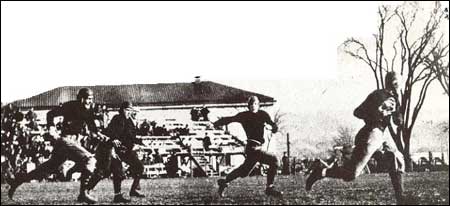Knute Rockne carrying the ball on The Plain, November 1, 1913
November 1, 1913, 100 years ago: The University of Notre Dame says hello.
Had this not happened, the South Bend, Indiana school might now be just another "mid-major" Catholic school in the Midwest, often with a good basketball team, but not a football school -- like Canisius in Buffalo, Duquesne in Pittsburgh, Xavier in Cincinnati, the University of Detroit Mercy, DePaul and Loyola in Chicago, Marquette in Milwaukee, and Saint Louis University.
But it did happen, and the Fighting Irish became, at least for Catholic Americans, the college football program.
From the start of the 1906 season to October 25, 1913, Notre Dame went 47-3-5, but most of that was against what were then called "small colleges." They had, however, beaten the University of Pittsburgh, 3-0 at Forbes Field on November 2, 1912, having played them to a 0-0 tie there in 1911. So it's not as though they hadn't played and beaten a big team before.
As a safety measure, the forward pass was legalized in American football in 1906. But it hadn't been used much by 1913. But Notre Dame quarterback Charles "Gus" Dorais and end Knute Rockne, an immigrant from Norway, had Summer jobs as lifeguards at a Lake Erie beach in Ohio. While there, they practiced passing the football of the time, rounder and less pointy than the one that would be developed in the 1930s.
So that when Notre Dame, 3-0, under new head coach Jesse Harper, took the field at The Plain on November 1, they were ready. Army, still stung by their shocking loss there the year before, to Jim Thorpe and the Carlisle Indian School, were 4-0, were not expecting another upset.
They got it. Dorais threw 17 passes, completing 14, for 243 yards. Rockne was the main receiver. Notre Dame won 35-13. For the 2nd year in a row, Army were beaten by a school that no one expected to beat them.
What's that? You didn't know that Knute Rockne had ever played? Well, there wasn't a National Football League for him to play in just yet. In 1915, Dorais-to-Rockne became the passing combination that led the Massillon Tigers to the Championship of the Ohio League. They played together until 1917, and then enlisted in World War I.
When "The War to End All Wars" ended, Rockne took his pharmacy degree back to South Bend, taught chemistry, and coached football. He coached Notre Dame to the National Championship in 1919, 1920, 1924, 1929 and 1930, before being killed in a plane crash in 1931.
Dorais coached at Dubuque College in Iowa; Gonzaga University in Spokane, Washington; and Detroit Mercy, before taking the reins of the Detroit Lions from 1943 to 1947. But by that point, the forward pass had been refined enough that Sid Luckman had quarterbacked the Chicago Bears to 4 NFL Championships in 7 years. The game had passed Dorais by. And he couldn't go back to Notre Dame, where Frank Leahy had taken over for Rockne, and kept the winning going. Dorais also died young, in 1954, after a few years of health difficulties.
*
November 1, 1913 was a Saturday. Baseball was over for the year, and the NFL, the NBA and the NHL hadn't been founded yet. But there were other college football games played:
* Harvard beat Cornell, 23-6 at Harvard Stadium in Boston.
* Colgate upset Yale, 16-6 at Yale Field in New Haven, Connecticut. The Yale Bowl opened the next year.
* Penn beat Penn State, 17-0 at the original Franklin Field in Philadelphia. The present Franklin Field opened in 1922.
* Princeton beat Holy Cross, 54-0 at University Field in Princeton, New Jersey. Palmer Stadium opened the next year.
* Rutgers lost to Wesleyan University, 20-9 at Neilson Field in New Brunswick, New Jersey.
Also, in their last season using that name, because it was their 1st season away from the locality in it, Woolwich Arsenal beat Nottingham Forest, 3-2 at the Arsenal Stadium in Highbury, North London.


No comments:
Post a Comment